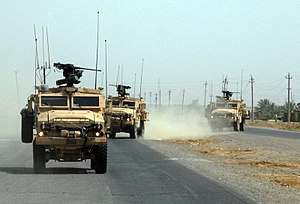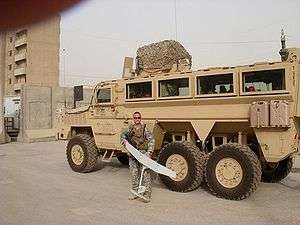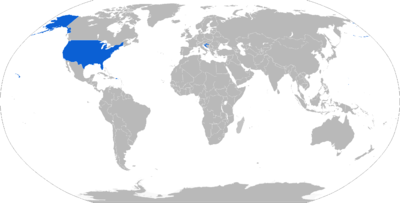RG-33
The RG-33 is a mine-resistant light armored vehicle initially designed by BAE Systems Land Systems South Africa (formerly Land Systems OMC) a South African subsidiary of BAE Systems. BAE Systems in the US extensively modified it with additional protection, new power train and suspension systems. It was built in a number of locations including York, Pennsylvania. It was one of several vehicles being fielded by the US Armed Forces in Iraq under the MRAP program.
| RG-33 (standard four wheel variant) | |
|---|---|
 | |
| Type | Infantry Mobility Vehicle |
| Place of origin | South Africa |
| Service history | |
| In service | 2007 – present |
| Used by | United States Army United States Marine Corps Croatian Army |
| Wars | Global War on Terrorism |
| Production history | |
| Designer | Land Systems OMC |
| Manufacturer | BAE Systems Land Systems South Africa |
| Unit cost | $300,000 |
| Variants | RG-33 (4x4) |
| Specifications | |
| Length | 22.1 feet (6,700 mm) |
| Width | 8 feet (2,400 mm) |
| Height | 9.5 feet (2,900 mm) |
| Crew | 4 + 2 crew |
| Armor | monocoque v-hull |
Main armament | Optional armored glass turret or remote weapon station |
| Engine | Cummins 400 I6 Diesel 400hp |
| Transmission | Allison 3200 |
| Suspension | 4x4 Double wishbone suspension |
| Ground clearance | 14 inches (360 mm) |
| Maximum speed | 68 miles per hour (109 km/h) |
| RG-33L (six wheel extended variant) | |
|---|---|
 | |
| Service history | |
| Used by | US Army US Marines Croatian Army |
| Wars | Global War on Terrorism |
| Production history | |
| Designer | Land Systems OMC |
| Manufacturer | BAE Systems Land Systems South Africa |
| Unit cost | $630,000 |
| Produced | October 2006 (RG-33L)[1] |
| Variants | RG-33L (6x6) |
| Specifications | |
| Length | 28 feet (8,500 mm) |
| Width | 8 feet (2,400 mm) |
| Height | 9.5 feet (2,900 mm) |
| Crew | 8 + 2 crew |
| Armor | monocoque v-hull |
Main armament | Optional armored glass turret or remote weapon station |
| Engine | Cummins 400 Turbo Diesel 400hp |
| Transmission | Allison 3200 |
| Suspension | 6x6 Double wishbone suspension |
| Ground clearance | 14 inches (360 mm) |
| Fuel capacity | 80 gal |
| Maximum speed | 67 miles per hour (108 km/h) |
Overview
It is based on the RG-31, which itself is based on the Mamba APC, although it is roughly twice the weight of a RG-31. There are two variants, the standard RG-33 has four wheels and weighs 22 tons while the extended RG-33L variant has six wheels, can carry twice as many people in the back, and weighs 26 to 37 tons depending on the version.
It was selected to be the sole producer of the US Army's $2.88 billion Medium Mine Protected Vehicle program.[2][3] The initial contract is worth $20 million. BAE representative Doug Coffey says that live-fire testing at Aberdeen, Maryland, proved the RG-33 to be the overall most survivable MRAP vehicle.[4]
The RG33 is manufactured in several configurations including the category I 4×4, category II 6×6, the heavy armored ground ambulance (HAGA) and the special operations command (SOCOM) vehicle.[5]
Design
It features a monocoque armored v-hull, for maximized interior space, seats and footrests suspended from the ceiling, run-flat tires, and an optional armored glass turret (Gunner Protection Kit or GPK), for maximized visibility and protection. The monocoque hull does not extend under the engine like some other armored vehicles. The engine compartment is a separate moncoque structure that bolts to rest of the hull. The vehicle is notable for its extensive use of TRAPP armored glass in the crew compartment. Like the Buffalo, it can be equipped with a robotic arm.
The U.S. has fielded 259 RG-33 4x4 variants in a Special Operations Command (SOCOM) configuration as shown above with remote weapon stations, two extra seats, and a rear door assist.[6] The U.S. has also fielded 16 RG-33L 6x6 variants in a Heavy Armored Ground Ambulance (HAGA) configuration.[7]
The Pentagon has future plans to add the Crows II remote weapon station, Boomerang anti-sniper system, and the Frag Kit 6 anti-EFP armor.
Production history
- On 26 January 2007, four (2 of each variant) RG-33s were delivered to the United States Marine Corps for testing.
- On 14 February, an order for 15 MRAP Cat 1 RG-33s and 75 MRAP Cat 2 RG-33Ls was placed under an Indefinite Delivery, Indefinite Quantity contract.[8]
- On 28 June, BAE received a $235.8M order for 16 RG-33 Cat 1 patrol vehicles, 239 RG-33L Cat 2 vehicles, 170 RG-33 Cat 1 variants for the United States Special Operations Command, out of their total allotment of 333 vehicles, and 16 RG-33L Cat 2 Ambulance variants, which are the first vehicles in the competition specifically listed for the ambulance role.[8][9] The vehicle can be mission configured for a number of roles including Infantry Carrier, Ambulance, Command and Control, Convoy Escort and Explosive Ordnance Disposal. On 18/Oct, an additional order for 600 MRAPS was received, involving 399 RGL-33L Cat 2, 112 RGL-33L Cat 2 Ambulance variants and 89 RG-33 SOCOM for 322 Million dollars. On Dec/18/07 a further order for 600 RG-33L Cat 2 was awarded to BAE Systems, for 645 Million dollars. To date, this gives a total of 1,735 RG-33 vehicles being ordered by the US Military.
- On 2 December 2012, BAE received a $37.6 million contract to convert 250 RG-33L 6×6 vehicles up to the Medium Mine Protected Vehicle status. Differences include a rear ramp for deploying unmanned ground vehicles, a new heating and air conditioning system, larger modular interior, high mobility chassis, extensive equipment options, larger bullet-resistant windows, and 360-degree situational awareness suite.[10]
Versions
- RG-33 (4×4)
- RG-33L (6×6)
Operators

- In service with the Burundian military.[11]
- Djiboutian Army - 10 RG-33 [13]
- Egyptian Army - 260 RG-33L + 90 RG-33L HAGA [14][15]
- Took delivery of 24 RG-33s after being refurbished.[16]
See also
- Buffel
- Casspir
- List of AFVs
- Mamba APC
- Matador (mine protected vehicle)
- Medium Mine Protected Vehicle - The U.S. Army Equivalent to the MRAP Program
- MRAP - U.S. Military Mine Resistant Ambush Protected Vehicle Program
- Nexter Aravis
- RCV-9
- RG-12
- RG-19
- RG-31
- RG-32
- RG-34
- RG-35
References
| Wikimedia Commons has media related to RG-33. |
- BAE SYSTEMS North America: News and Information: News Releases Archived 18 October 2006 at the Wayback Machine
- "BAE Systems - AUSA 2008 - RG33 Series Mine Protected Vehicles". Archived from the original on 5 November 2014. Retrieved 5 November 2014.
- "'Panther' designed to keep troops safer". Herald-mail.com. 28 December 2011. Archived from the original on 30 June 2009. Retrieved 1 January 2012.
- "Diversity Adds Depth to MRAP". Military.com. Archived from the original on 23 October 2007. Retrieved 1 January 2012.
- "RG33 Mine-Resistant Ambush Vehicle (MRAP)". Army Technology. 15 June 2011. Archived from the original on 18 February 2010. Retrieved 1 January 2012.
- "SOCOM variant". Archived from the original on 5 November 2014. Retrieved 5 November 2014.
- "HAGA Variant". Archived from the original on 5 November 2014. Retrieved 5 November 2014.
- "BAE's Diverse MRAP Orders". Defenseindustrydaily.com. 18 December 2011. Retrieved 1 January 2012.
- "BAE's Diverse MRAP Orders". Defense Industry Daily. 18 December 2011. Archived from the original on 2 July 2007. Retrieved 1 January 2012.
- BAE receives contract to convert RG-33 MRAP into MMPV Archived 5 December 2012 at the Wayback Machine - Armyrecognition.com, 2 December 2012
- https://web.archive.org/web/20170622123315/http://www.janes.com/images/assets/520/71520/New-model_African_armies.pdf
- 20 Vehicles Croatia takes delivery of 30 MRAP MaxxPro armoured donated by the United States Government Archived 15 April 2014 at the Wayback Machine - Armyrecognition.com, 10 April 2014
- "Djibouti Air Force gets two Y-12s; Dauphin helicopters". defenceWeb. 2016. Archived from the original on 20 July 2016. Retrieved 19 July 2016.
- "U.S. Delivers Armored MRAP Vehicles to Egyptian Military". 12 May 2016. Archived from the original on 13 May 2016.
- "Excess Defense Articles (EDA)". Archived from the original on 17 May 2016. Retrieved 13 May 2016.
- https://web.archive.org/web/20170622123315/http://www.janes.com/images/assets/520/71520/New-model_African_armies.pdf
- "US Marines order 90 SA vehicles". 20 February 2007. Archived from the original on 23 February 2007. Retrieved 20 February 2007.
External links
- baesystemspresskit.com, (membership required to access/view)
- Deagel.com: RG-33